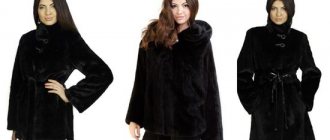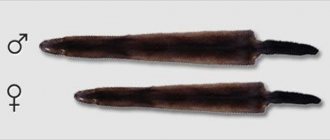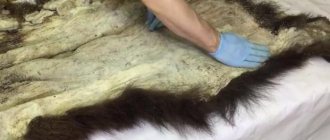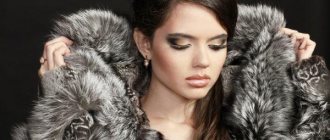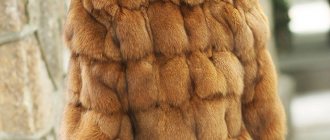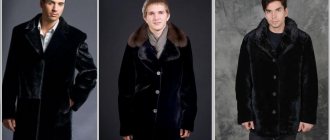Product Features
A bear fur coat is highly resistant to low temperatures. Perfect for wearing in harsh winter conditions; it is impossible to freeze in such a fur coat, even if you spend the whole day outside. If properly made, the product will serve its owner for a long time.
Bear and girl
Another advantage of this fur, in addition to its resistance to frost, is its rich range of colors. A natural bear can be:
- brown,
- fawn,
- brown,
- white.
The photo shows that bear fur has a characteristic thickness, full of undercoat and high hair. In addition, it has the following characteristics:
Advantages and disadvantages
Bear fur coats for men and women have pros and cons that are worth evaluating when purchasing a product.
The advantages include:
- original look;
- good wear resistance;
- frost resistance;
- unpretentiousness in care and maintenance.
The following are noted as negative points:
- high cost;
- the heaviness of the fur coat;
- unusual type of product.
The choice of models made from such fur is very limited. The product is most often made to order.
Warm fur coat
Forest representatives
Brown bear is a solid fur for a man. It is chosen by extraordinary individuals who strive to emphasize their individuality in everything.
The fur of a brown bear has the following characteristics:
- density,
- warm,
- elasticity.
Men value bear coats for these qualities. The best products are made from fur obtained in winter, when the bear grows fur to keep warm during hibernation. The color of such a product will be uniform, and the quality will be much higher, since during this period of time the animal sleeps peacefully.
brown bear fur coat
You should not choose men's fur coats made from the skins of spring and summer bears, despite the fact that they can be significantly cheaper. The appearance of such a product is unaesthetic, and the fur does not have the characteristic shine and thickness.
Bear fur coats are quite simple, straight-cut and too heavy, so such a thing is considered purely masculine.
Men's brown bear fur coat
Shooting and processing of bear skins
The brown or forest bear inhabits the entire forest belt from the western border of our country to the Pacific Ocean; it is also common in the mountain forests of the Caucasus and Altai.
Fur color and size
It is smaller in size than a polar bear, but larger than a black one. The length of its skin can reach 2 m.
His fur is tall, thick and rough. The color can be from dark brown to light brown. Due to the fact that the animal inhabits zones with different climatic conditions, its variability is well expressed, which is manifested in the difference in the basic properties of the fur, as well as its color.
Geographical and individual variability:
- Animals hunted in the Far East are the largest, their fur is high, thick and soft. The color is predominantly dark brown.
- The skins of East Siberian individuals are close in characteristics to those of the Far East, they are only slightly smaller, and in addition to dark brown, there are also brown ones in color.
- From Western Siberia and the central regions of the European part, the animals are of medium size, the hair is medium in height, density and softness. The populations are dominated by individuals with brown coloration.
- Animals living in the mountains have skins that are significantly smaller than their northern counterparts. The hair is not as lush, thick and soft as that of other subspecies. The color is mostly light brown with a dark spot on the nape.
The habitat and biology of the brown bear can be found in this article.
In the accepted standards, all skins of this predator are divided into several size categories, which are determined by the area of the skins.
Small - area - 65-100 square meters. Medium - 100-125 dm.sq. Large - over 135 dm.sq.
This division is due to the fact that bears differ greatly in age and gender. Young individuals reach the size of an adult animal only by 5-6 years, and females are much smaller than males. The area of the hide is measured by multiplying the length and width results. The length is measured from the middle between the eyes to the base of the tail, and the width is measured in the middle of the length measurement.
1
Animals moult once a year. It begins about a month after its awakening in the spring and ends before hibernation.
Quality and evaluation of hides at different times of the year
First grade (winter). The fur is fully formed, tall, thick and shiny.
First grade, medium defect (early spring). Its properties are almost the same as the winter one, but less shiny, there are minor abrasions in places.
First grade, large defect (spring). The hair is dull, thinning, very frayed on the sides and rump.
Non-standard (late spring, summer, early autumn). At the end of spring there is active molting. The cover is faded, falling out in shreds in places. New growth begins in these places. In summer the fur is low and sparse, with virtually no fluff. At the beginning of autumn, new hair is just beginning to grow, there is still very little fluff.
Third grade (autumn). The undergrowth is low, but already thick, the fluff has only grown by half.
Second grade (late autumn). The fur is thick and shiny, slightly inferior in height to the winter coat.
Processing rules
After shooting a bear, it is necessary to skin it as soon as possible, especially in warm weather, and cut up the carcass - the healing properties of bile, the quality of fat and meat deteriorate very quickly.
A bear skin, as a rule, has only trophy value; it is used to make carpets or stuffed animals, so you should be very careful in its removal and initial processing.
It must be removed in a layer (carpet) while preserving the paws with claws, tail, head with nose, lips, eyelids and ears. At the beginning of the survey, a longitudinal incision is initially made along the midline of the neck, chest and abdomen, from the lower lip to the base of the tail. Next, a circular incision is made around the anus, and then the tail is cut along the lower surface. The next step is the cuts on the paws: on the hind legs, a cut is made from the middle claw, through the hock joint, along the border of the hair of the rump and the womb to a ring cut around the anus. On the front ones, the incision also starts from the middle claw and runs along the inside of the paw at a right angle to the middle of the chest. The soles of the paws are left on the skin in case it is used to make a stuffed animal.
Next, we continue to remove with caution, subcutaneous fat greatly interferes with this process, it should remain on the carcass. Photographing after whitening is carried out both in a horizontal position of the carcass and in a suspended position.
The removed skin is thoroughly degreased, avoiding cuts and damage to root hairs.
Canning and vices
Canning is possible using the fresh-dry method and salt.
The first option was widely used previously and was recommended by GOST for fur raw materials.
Editing is done on a frame made of boards. You should not stretch it too much; during the shrinkage process during drying, tears may appear in the places where it is attached to the frame. If it is impossible to make a frame, you can dry it on a horizontally hanging pole with the inside out. At first, it is necessary to periodically straighten it, preventing the edges from curling and move it so that prelins do not form in places of contact with the pole. The paws need to be further straightened. To do this, boards of the required size are selected, and the skin from the paws is nailed to them; you can also straighten them by inserting spacers from sticks across the paws.
2
Currently, procurement organizations refuse to accept dry skins, so it is advisable to salt the raw materials. True, you will need a lot of salt and a cooler place. Particular attention should be paid to problem areas where cartilage and tendons are present.
The bear's skin is quite thick and durable, so such a defect as tearing is rare. The following are more common: undercuts, slits, drafts, poor degreasing, lump drying, etc.
Bear skins are rarely tanned themselves; their large size is the main reason for this, although if desired, it is quite possible to do this at home. The main points of the technology of the dressing process can be found here.
Guest from a frosty country
Polar bear fur is a kind of exotic. The cost of such skins is quite high, since the polar bear has fur of higher quality, as well as a more interesting appearance.
The main advantages of white fur are that:
- a polar bear fur coat retains heat even at extremely low temperatures;
- white fur does not get wet, since the polar bear spends a sufficient amount of time in the water;
- The polar bear is one of the rare animals listed in the Red Book.
A polar bear fur coat for men is super exclusive. The cost of such a product will be high.
Polar bear fur coat
bear fur
Bears are so different
Bears (lat. Ursidae) are a family of predatory mammals. They live throughout North and South America, northern Europe and Asia.
In the 20th century, the numbers and ranges of all bear species declined sharply, necessitating the introduction of restrictions on shooting and protection. The lists of the International Red Book include: the giant panda as an endangered species (Endangered), the Himalayan, spectacled, polar bears and sloth bears as vulnerable species (Vulnerable).
Bears have a stocky build. Bears are omnivores, climb and swim well, run fast, and can stand and walk short distances on their hind legs. They have a short tail, long and thick hair, as well as an excellent sense of smell and hearing. They hunt in the evening or at dawn. Bears are not susceptible to bee stings. In nature they have almost no natural enemies.
Fur with developed undercoat, rather coarse. The hairline is tall, sometimes shaggy; in most species it is thick, in the Malayan bear it is low and sparse. The color is uniform, from coal-black to whitish; The giant panda's color is contrasting, black and white. There are light markings on the chest or around the eyes. Some species have individual and geographic variation in color. The color does not change with the seasons; seasonal dimorphism is expressed in changes in the height and density of fur.
Bears are favorite objects of keeping in zoos and training, including circus training. They are usually afraid of humans, but can be dangerous in places where they are not used to people, especially polar bears and grizzly bears. Mother bears with cubs are especially dangerous. In some cases, bears can harm crops, beekeeping, and livestock.
Bears (lat. Ursus) are a genus of mammals of the carnivorous order. Currently, there are 8 species of bears divided into 5 genera.
According to paleontological information, the genus of bears appeared 5-6 million years ago. Its first representative is currently considered to be the bear Ursus minimus, a relatively small animal whose fossil remains were found in France. All four modern species of the genus, as well as a number of extinct ones (for example, the cave bear Ursus spelaeus) descend from the Etruscan bear (Ursus etruscus), which lived 2-1 million years ago. The youngest species of the genus is the polar bear, which split from the brown bear approximately 200,000 years ago.
The white or polar bear (Ursus maritimus) is the largest carnivore of all bears. Males weigh on average 450-500 kg, sometimes reaching 800 kg, in rare cases up to a ton. The weight of females averages 320 kg.
The brown bear (Ursus arctos) is the most common species of bear, capable of adapting to a wide variety of habitats. Brown bears feel great in the taiga, semi-deserts, mountains and beyond the Arctic Circle. Due to the huge distribution area of the brown bear, many subspecies have formed, which differ greatly from each other in size and appearance. There is no other animal on Earth that exhibits such a range in weight. The smallest bears of this species weigh about 100 kg, and the largest ones sometimes weigh a ton.
The black bear, or baribal (Ursus americanus) is found exclusively in North America, where it is much more widespread than the brown bear. Baribal is in many ways similar to its closest relative, the brown bear, but it is noticeably smaller in size, it has a narrower head and larger ears. The weight of baribal is usually approximately 150-200 kg, sometimes the weight of some males exceeds 250 kg.
The Himalayan, white-breasted, or Asian black bear (Ursus thibetanus) is approximately the size of a baribal, but is noticeably different from it in the structure of the skull. The coat color is the same as that of a black bear, but there is always a white spot on the chest in the shape of the Latin letter “V”.
The sloth bear (Melursus ursinus) has a very distinctive appearance. The color of the sloth bear is similar to the Himalayan bear, with the same characteristic spot on the chest. The coat is long and shaggy. Sponge fish weigh on average 80-100 kg, some males can reach 140 kg. Its diet is based on termites and ants.
The Malayan bear, or biruang (Helarctos malayanus) is the smallest of the bear family.
Spectacled bear
(Tremarctos ornatus) is the only representative of the bear family in South America. The spectacled bear prefers mountain forests, but sometimes descends into more open spaces. Often climbs trees and is a good climber. Along with the giant panda, this is the most herbivorous of the bears. The weight of a spectacled bear is approximately 100-150 kg, with an average of about 130 kg.
The giant panda (Ailuropoda melanoleuca) is the most distinctive species of bear.
The importance of bear prey
The object of commercial and sport hunting is the brown bear. The benefits brought by bear hunting are very significant. Previously, heavy and lush bear skins were used for carpets and road fur coats. Mostly they made a cavity into which the sleigh rider was covered.
The bear is a valuable game animal, the skins of which are constantly exhibited at Canadian wild fur auctions. The length of a bear skin can reach 3 meters. The wear resistance of brown bear fur is 65%.
The bear's fur has a thick pile with a high, thick undergrowth. Bear fur can be of different lengths and colors. Rare dark brown color. Bear fur is considered the warmest. According to historical data, high fur boots made of bear hair were worn by Peter II himself. Bear fur - a bear skin can cure a disease such as gout: if you lie on it during an exacerbation of the disease, the pain goes away.
If you were lucky enough to visit Amalienborg Castle in Copenhagen, Denmark, you should have paid attention to the guards in traditional bearskin hats. Traditionally, the Danish and British guards were supplied with the fur of the black bear - baribala - as material for headdresses. Once upon a time, baribals were caught in Russia. The very first samples of hats were presented to the Danish king by his son-in-law, Emperor Alexander III.
If during World War II the royal guard managed to somehow express itself, now it often evokes ironic smiles among tourists: the young and thin guardians of Queen Margrethe II’s peace look very funny in their powerful headdresses. And in vain the onlookers chuckle - they should try to stand in the sun themselves, holding half a kilogram of bear fur on their heads. The guards cap is approximately 40 centimeters high and weighs more than 600 grams.
The polar bear has a very special fur, water quickly drains from it, and it retains heat well from the body. The thick fur of a bear retains heat due to the specific arrangement of the fur hairs, creating an air cushion. Polar bear fur very rarely appears on sale, as it is listed in the Red Book.
Bear fur is graded based on the size of the skin. Small bears are practically not valued. Bear skins are now used for interior decoration. The skins are hung on walls, used as carpets, or made into decorative stuffed animals. Bearskin is also used for upholstery of ottomans, car seat covers, toys, souvenirs, and hats.
The best bear skin is obtained in winter, when climatic conditions force the animal to grow thick fur. In winter, the bear remains in its den, so its skin does not have the characteristic damage caused by the activity of the animal. The bear skin obtained in the fall is worse than the winter skin, but is still suitable for dressing. As a rule, the quality of the autumn skin increases from the beginning of September to October, which is associated with the growth of underfur.
Bear meat is highly valued. The meat of young bears has a delicate, pleasant taste; fried or smoked hams of adult fatty bears are considered a delicacy. Paws are especially prized by gastronomes. Bear's head is also considered an excellent dish.
Bear fat is easily sold and paid dearly. The fat is white in color, does not harden or turn bitter in closed containers, and when fresh it has a nasty taste that disappears only when it is boiled with onions. Bear fat is famous as a good remedy for hair loss.
Bear bile is also highly valued because it has healing powers: it helps against fever. Therefore, after a happy hunt, its participants generously treat themselves to vodka, to which they mix a little bile of the killed animal. Bear fat and bile are used in traditional Chinese and Japanese medicine to treat diseases of the liver and bile ducts, kidneys, and severe burns.
Bear in heraldry
In heraldry, a bear, because it foresees the weather, knows how to hide in time in a den, where it prepares a lair for itself, is considered a symbol of foresight and is revered as passing (French passant) when walking, and rising (French leve) when standing on its hind legs .
The bear has been the heraldic symbol of Berlin since March 22, 1280. This day is dated a message from the Berlin Furriers' Guild, which bears a seal with two bears.
The bear is depicted on the coats of arms of Russian ancient cities - Yaroslavl, Sergach, Volsk, Novgorod and Perm. On the coat of arms of Maloyaroslavets, a bear is depicted in a den. The Yaroslavl bear even appeared on a banknote with a face value of 1,000 rubles.
There is also a "golden bear" at the Berlin Film Festival. He visited our country only twice, for the paintings “Ascension” by Larisa Shepitko and “Theme” by Gleb Panfilov.
Rivers, lakes - the Great Bear Lake in Canada, waterfalls, caves, gorges, cities - Medvezhyegorsk, streets in Warsaw - are named after the bear. And even the football club - the Chicago Bears, probably the owners of the team, deep down in their souls, were guided by the same motives as their distant ancestors, who chose the spirit of the bear as their patron. In England there is a monument to a bear at a train station, after which the clubfoot is named.
In the Caucasus, one of the passes is called the Bear Gate. The surname Medvedev is widespread. The bear is the only animal that Russians lovingly call by its human name - Misha.
In 1950, in the US state of New Mexico, after a forest fire, a bear cub with severe burns was brought to the zoo. He was cured and named Smokey. Now his image has become a symbol of the fight against forest fires. This example shows that good traditions can be born in our time.
Legends about Mount Ayu-Dag - Bear Mountain
Many vacationed in Crimea and remembered Mount Ayu-Dag, translated from Turkic as Bear Mountain. It is very similar to the silhouette of a bear lying by the water. There are two legends explaining the origin of Bear Mountain.
The first legend says that a long time ago bears lived on the shores of the Black Sea. One day a storm washed ashore a boat with a little girl in it. The bears raised her. And then this girl met a young man and sailed with him to people. And the leader of the bears lay down on the seashore and watched the ship disappear over the horizon. It still remains that way.
The second legend says that a long time ago people lived on the shores of the Black Sea. They had a deity that they worshiped. Then they relaxed and stopped worshiping their god. Then God went north, released a huge bear from his den and instructed him to re-educate these people. The bear sailed to the South and began to destroy everything that came under its paws. But when he got to the Partenite Valley, he really liked the local climate and decided to stay in this beautiful region forever. Then the indignant god turned the bear into stone the moment he drank sea water. This is such a sad story.
Legends about bears
The bear is a significant animal of Russian culture, appearing in literary works, folk tales, epics, and sometimes as the main character in Russian proverbs and sayings. In Russian folk tales, the bear is presented as an intelligent, playful animal that lives not far from people.
In Rus', the most popular animal was the bear. One can feel people's sympathy and respect for him. “You, bear, you are my father,” sang in an old song. The bear was called Toptygin, Mikhail Ivanovich.
In western Russia, the bear was revered, and the day before the Annunciation was dedicated to celebrating the bear. On this day, special dishes were prepared - dried turnips and oatmeal jelly, as a sign that the bear loves oats and pea comas, and the holiday itself was called “komoeditsa”. After lunch, everyone, old and young, lay down and every minute, slowly rolled from side to side, imitating a bear in a den. This lasted about 2 hours with the goal of making it easier for the bear to get out of its winter den. It was forbidden to work on this day.
By the way, there is an interesting view on the ancient practice of driving bears through villages. In the Nizhny Novgorod town of Sergach alone in 1813 there were about 2 thousand “scientific” bears. Bear drivers, buffoons, were considered a kind of wizards, and any driving of a bear was intended to promote the fertility of fields and women - the bear must step over a lying woman. In Ukraine, a bear was led around the village, and women approached it to experience fertility. A pregnant woman gave him bread; if he accepted it silently, it would be a boy; if he roared, it would be a girl.
The bear is a totem among the Slavs of Kievan Rus. For many Slavs, a bear crossing the road means good things. Ukrainians said that a bear is a converted miller. The bear protects the miller, saving him from visiting the merman, the South Slavs believe. In legends about various saints, bears give up their dens to them. According to another belief, God turned a man into a bear who decided to scare him with a roar. Holy hermits, as countless apocrypha testify, often lived in the same cave with a bear.
Russians believe that evil spirits cannot take the form of a bear. “The bear is from God,” they said in the Olonets province because the first bear was a god. Belarusians call the bear “forest archimandrite.” The human origin of the bear explains the prohibition of killing a bear and eating its meat among the Rhodopean Bulgarians. Bears attack people only at the direction of God, for their grave sins. A bear can remove damage from livestock. A bear seen in a dream foretells the return of a loved one. For Russians, meeting a bear means good luck. In Macedonia, the bear is invited for dinner and hominy is prepared. The bear is a pure animal, a symbol of health and strength.
The legends and traditions of the northern peoples mention the owner of dense forests - the brown bear. Traditions of many peoples consider the bear to be one of the ancestors of man. Compared to other inhabitants of the forest - elk, roe deer, hares, foxes, which were hunted to satisfy the needs of life, the bear was hunted for a different purpose. The fact is that a bearskin was considered an effective protective amulet against evil spirits and all sorts of other misfortunes. Among the northern peoples, who still live in unity with nature, it is customary to cover the entrance to the yaranga or tent with a bear skin to scare away evil spirits from the home. The mighty leaders of the tribe and the strongest, most successful hunters sought to make a bed of bear skin in their home. Only an experienced hunter, well-prepared physically and enjoying universal respect, was able to catch a bear. The bear skin he obtained was evidence of the listed qualities.
It has always been believed that shamans have an astral connection with the bear. By dressing in a bearskin, the shaman provided himself with a connection with higher spirits. The skin of a bear was a mandatory attribute of the shaman’s home.
There is a belief that the bear himself was once a man, and was dressed in brown bear skin for bad behavior and disrespect for the gods. In the Arkhangelsk province the mole was called an “earth bear.” And they revered it very much, believing that it scared away a real bear.
A bear hunter in the Urals must carefully guard the skin of the animal he kills, otherwise the girls will steal his claws. According to legend, the claw of the fourth toe of the right front foot has extraordinary miraculous power: if a girl manages to secretly scratch her beloved guy with it, he will fall in love with her passionately.
The Ostyaks attribute mysterious powers to the bear's fangs. The bear tooth serves as a talisman for the Ostyak, saving him from illness and danger. It also has the ability to expose deception and deceit.
The bear is especially respected by the northern peoples - Ostyaks, Ainu, Gilyaks, Samoyeds and Voguls. Among the Ainu, the bear is called the god of the mountains. The Ostyaks call him the son of heaven, who descended to earth, contrary to the will of his father. It is believed that the soul of a bear is immortal. Among the Udmurts, the bear is a totem animal. The Buryats forbade a hunter to kill more than 99 bears in his life. The Evenks believe that you cannot kill more than 60 bears in a person’s life. The Eskimos of Greenland respectfully called the bear “grandfather” - the owner of the land, “big man”.
The bear is the king of groves and forests, say the Yakuts. And yet - the bear is smart, like a person, and if he doesn’t speak, it’s because he doesn’t want to. Or - don’t speak ill of the bear, don’t brag, he hears everything, even though he’s not nearby, remembers everything, and doesn’t forgive. The bear is a thinker. The bear has a lot of thoughts, but none of them. Among the Vilyui Yakuts it was forbidden to attack a bear by surprise; when they approached the den they woke it up. When a Nyuret accidentally came across a bear in the forest, he took off his hat and respectfully said: “Go on your way, venerable one.” The bear took off his fur coat and became a man, say the Gilyaks. The Ostyaks of the Tobolsk province apologize to him before shooting at the bear. The Nenets say that a polar bear taught them how to use fire. The Altaians assured that the bear hears through the ground. In Norway it was believed that a bear that attacks a person is non-Christian; a Christian bear will never attack.
The cult of the bear is widespread among the Zyryans. On September 1, according to the old style, the Zyryan villages celebrated the holiday “Osh Chualan Lun” - which means “the day of the bear’s favorite adventures.”
Among the Mari, the bear embodied the divine masculine principle. Hunting for it is prohibited; the places where it lived were preserved. Mari were known to Novgorodians in ancient times as bear worshipers - they had a system of bear calendar holidays. During one of them, people in bear skins walked around the village and gave gifts. A bear is a creature equal to man, demanding respect. Who doesn’t remember the fairy tale about the bear on a fake leg? This ancient hunting story, found among Russians and Maris, says that meanness towards an animal will always be punished, just like meanness towards a person. The old man cut off a leg from a sleeping bear and paid severely for his dishonorable act.
The Dagestanis have a curious epic “Sultan Bey and the Bear”. One winter, the hunter Sultan-bek walked through the forest at night and fell into a bear’s den. There was a bear there, with whom he began to live as “husband” and “wife.” For this, she soon helped him escape from snow captivity. When Sultan-bek returned to his village and told the people about everything that had happened, they, as a sign of gratitude, brought the most well-fed bull to the bear.
Among the Iroquois, bears were considered saints. In India and some American tribes, the bear is treated like a baker. One Indian myth tells how a man lived with a black bear, and he taught him how to catch salmon and build boats. When there were difficulties, the man went to the bear and he always helped him. For this, a man painted an image of a bear on his house.
Product selection
The polar bear is presented on the market in limited quantities. The fur of a polar animal has many advantages, as products made from it are warm and wear-resistant. Usually men make the choice in favor of a polar bear.
There are also products made from white fur for women, but before purchasing you should evaluate your strength, since fur coats made from polar animals are quite heavy.
Men can choose a long fur coat or a midi, but short polar bear fur coats are suitable for the fair sex.
Despite the fact that the polar bear is listed in the Red Book, its fur is still harvested. If the skin is not processed in a handicraft way and is obtained legally, then the cost of the product will be decent. Brown fur is mined more often, but products made from it do not go to the big market; more often such things are sewn to order.
When buying such a fur coat, you can be sure that the appearance will be the most attractive. Such fur will emphasize the individuality and originality of its owner. It is really worth choosing a bear coat for a harsh winter, since in the European climate it will be quite hot. In a fur coat, you don’t have to worry about getting wet; thanks to its high water-repellent properties, it’s not afraid of water.
Leave your comment:
The mystery of polar bear fur
The polar bear will teach you how to bask
Why is it that a polar explorer, even in a modern, insulated room, is forced to wear warm clothes, but a polar bear, who walks around in the cold all day, does not freeze at all? After all, his fur is thin - only five centimeters thick! Recently, scientists found the answer to this question - it turns out that the problem is not in the thickness of the heat insulator, but in its structure, informs A. Evseev, www.pravda.ru.
It should be noted that the question of why polar bears, having a fairly small heat-insulating layer (their fur is not so thick and dense), nevertheless calmly withstand Arctic temperatures, has been bothering scientists for a long time. And the point here is clearly not the abundant fat layer under the skin - by the end of winter the bear has almost none of it left, but the animal does not even think about freezing. Most likely, the point is in some principles of thermal insulation that are not yet completely understood by people, by studying which we could create a substance, the thinnest layer of which could save us even in the most severe cold.
And recently, a group of scientists from Belgium and Morocco, led by Priscilla Simonis, representing the University of Namur (Belgium), decided to try to solve this mystery of nature. First, the researchers conducted a series of experiments, as a result of which they found that the constant temperature of the bears does not fall even during long winters with minus 40 degrees Celsius. And this is with a fur thickness of only five centimeters! It is almost impossible to imagine that such thin woolen outerwear can withstand the cold as effectively. And so do the heat insulators used in building houses.
“Why do we need at least 60 centimeters of mineral wool or glass wool in order to maintain 20 degrees at temperatures around minus five? And why is polar bear fur better than what we develop for insulating houses?” - Dr. Simonis, the lead author of the study, asks pathetically. At the same time, she adds that a layer of heat insulation 60 centimeters thick around the perimeter is in most cases a completely unimaginable figure, which in practice is rarely achieved for the same walls; usually the layer of heat-retaining substance is much thicker.
In order to solve the mystery of polar bear fur, scientists started with the basics: they remembered exactly how heat can leave a body. There are two known ways to freeze: with the help of radiation, when cooling occurs through the emission of electromagnetic waves in the infrared range, and with the transfer of vibrations of atoms and molecules of a heated body to nearby colder ones. It was believed that the latter method loses more heat, so the standard method of reproducing natural insulating materials in the process of evolution mainly takes it into account. That is why there are many air cavities in the wool and feather cover. Thanks to their presence, molecules and atoms of a solid body (and the body can be equated to such) will give off heat to much more rarefied air, making heat loss much more difficult. Based on the same principle, man created artificial insulation from foam plastic and glass wool.
However, researchers in Dr. Simonis's group suggested that perhaps traditional models are not accurate because they underestimate the importance of radiative heat loss. And in order to prove this assumption, they themselves simulated the process of heat transfer by radiation under conditions that prevent the spread of infrared radiation, while trying to reproduce the real situation with animal fur, in which individual fibers prevent infrared electromagnetic waves from freely moving away from the body into the surrounding space ( that is, they are a kind of “IR radiation traps”).
As a result, it turned out that when constructing such a model, protective layers with absorption characteristic of a black body were used, the efficiency of the fur was relatively low. By making the protective layers light, it was possible to achieve a sharp drop in heat transfer. In general, the model constructed by the researchers leads to a seemingly obvious conclusion: repeated scattering of infrared radiation between numerous layers that prevent the spread of radiation suppresses the process of cooling a heated body and heating a nearby cold one.
According to Dr. Simonius, there is a strong possibility that such a mechanism may actually be more important in the insulating properties of fur and feathers than blocking other heat transfer pathways. And that is why its development was supported by evolution among those living creatures that constantly live in very cool places on our planet. Moreover, this structure of fur and feathers not only scatters far-infrared radiation, but also does the same with visible light, which makes polar animals appear white in the visible range, adding effective camouflage to excellent thermal insulation.
Well, since nature did this, then people should also apply a similar method of creating insulating materials in their everyday life - for example, include unusual multilayer components with high reflectivity (this could be some metals) in the composition of ordinary heat insulators. Well, the best form for such insulation may be just a “fur” structure, where instead of spaced layers, various thread-like formations will be used. With the help of such ultra-thin artificial materials it will be possible to achieve much more effective thermal insulation than that provided by foam plastics and glass wool...
On the screensaver there is a photo from the site forumishka.net
